Forum Replies Created
-
AuthorPosts
-
 Derek RobsonParticipant
Derek RobsonParticipantHi Alex
I’ve been occasionally looking at Orion clips on my meteor video camera. I started to see some dimming of Betelgeuse last year and since then, it was evident just comparing with Rigel. But last night and Wed morning, I thought?? I noticed Betelgeuse looked as if it was getting brighter again. Anyone notice something like this in the last 24 hours?
 Derek RobsonParticipant
Derek RobsonParticipantYou obviously like star atlas’s. After reading all this wonderful advice from all the posters, I’m spoilt for choice. I can see a few purchases ahead. I’m glad you got prompted 🙂
 Derek RobsonParticipant
Derek RobsonParticipantI saw the blue desk version for about £70, and a field version for about £140 odd. The ad shown shows the field version to be less than half at £63. I suspect an error in pricing for the field version in that ad. I didn’t notice the error in the title.
 Derek RobsonParticipant
Derek RobsonParticipantWhat a splendid gentleman.
 Derek RobsonParticipant
Derek RobsonParticipantGreat stuff
 Derek RobsonParticipant
Derek RobsonParticipantBrilliant idea. I have a TV and a 24″ monitor several feet from the laptop, but the laptop can be moved closer.
 Derek RobsonParticipant
Derek RobsonParticipantThat’s very interesting. Yes, send his contact details. I have C2A which uses a number of digital catalogues such as UCAC4, and TYC. I’m not as familiar with it as I am with Stellarium. But hope to progress with C2A. The Tycho catalogue may be of interest in print form seeing as I have it that works in the background of C2A.
 Derek RobsonParticipant
Derek RobsonParticipantJames
Thanks for listing those. I didn’t know off of those, but it will be great to have a look and compare. I do like Stellarium too, and like the way I can do on line search for an object such as an asteroid, that is not listed. But I can download the data and Stellarium can then display the object. That’s very helpful, and obviously not possible with books, but both have their advantages. Thanks for the list.
 Derek RobsonParticipant
Derek RobsonParticipantThank you Callum. I have since read some really positive reviews of that one, including the quality and strength of the paper when used in field conditions. I had been focusing on that one. This is going to be interesting.
 Derek RobsonParticipant
Derek RobsonParticipantThanks for those pictures, I like the look of those very much. Nice in colour too. Hmmm, I’m spoilt for choice here.
 Derek RobsonParticipant
Derek RobsonParticipantThanks. I will look it up.
 Derek RobsonParticipant
Derek RobsonParticipantHi Nick
Some interesting observations. If the almost vertical slotted lines are the satellites, then what are the thicker almost horizontal lines? My system had been picking up slotted curved lines with a rough angle of 45-60 degrees relative to the horizontal, which are probably satellites. But meteors on the system show up a fleeting pings which are vertical, and the longer duration ones tend to be asymmetrical, sometimes have a E shape and sometimes a spiral extension. Occasionally I see lines which wander above and below the zero hertz frequency line (Y=0), and sometimes they are solid or dotted – I think these are certain beacon transmissions. But I’ve not seen examples of what you are detecting showing almost horizontal lines with a slight slope, then repeats itself.
In the image I’ve uploaded, you can see the satellites are interfering with the software’s meteor recognition causing inflated count rates, which are difficult to manage by manual subtraction methods, which are time-consuming and not practical.
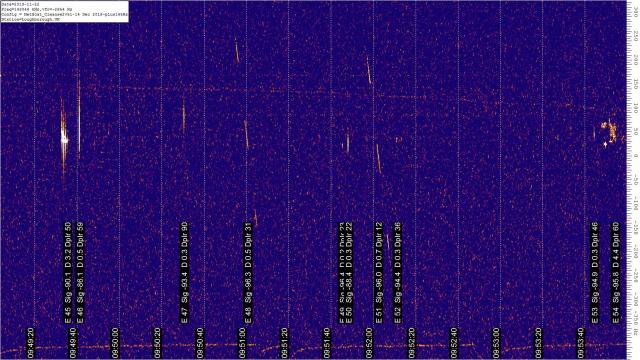
 Derek RobsonParticipant
Derek RobsonParticipantA lot of useful information Tim. Instructions file and graze files all downloaded.
 Derek RobsonParticipant
Derek RobsonParticipantGood to learn of those results Robin.
 Derek RobsonParticipant
Derek RobsonParticipantEric
Thanks. William built and tested my equipment. With William’s expert help, you should have no problem. Wishing you all the best for your first fireball capture.
Derek
24 November 2019 at 1:11 pm in reply to: Prediction of high activity of alpha Monocerotid shower #581640 Derek RobsonParticipant
Derek RobsonParticipantI started watching my meteor radio detector screen from 22/11/2019 04:38 UT. The system uses a 3-element Yagi and Fun Cube Dongle tuned to the Graves radar frequency (my system set at 143.048 MHz). There was a relative increase in activity seen at ~04:39 till ~05:06 UT – definitely a greater rate than 3/hr (the normal visual alpha Monocerotid rate). On average ~10 events/5 minutes (120 events/hour). Signals of longest duration occurred between 04:35 – 04:43 UT [04:35:31, 22.4s, Doppler 43; 04:39:15, 3.6s, Doppler 57; 04:42:46, 12.3s, Doppler 42]. Selection of 5-minute screenshots of radio activity for the time period 04:30 – 05:06 UT. It was raining here in Loughborough, Leicestershire, UK, so no visual meteors to report.
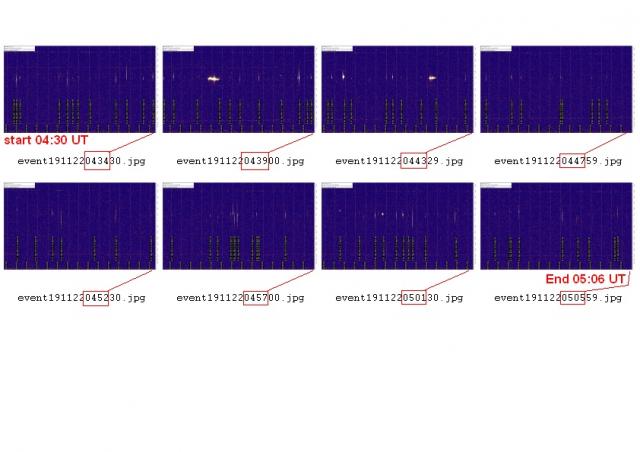
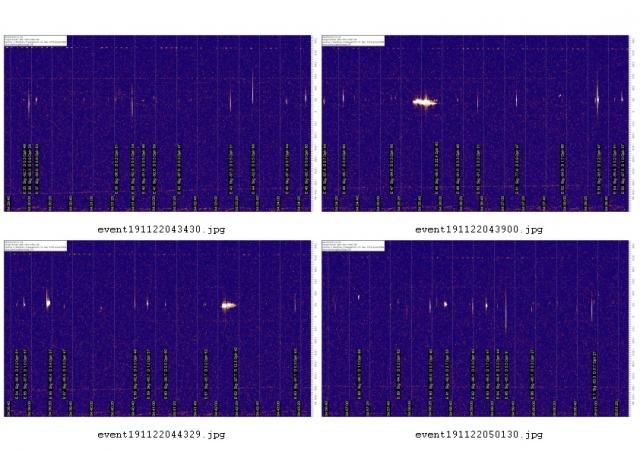
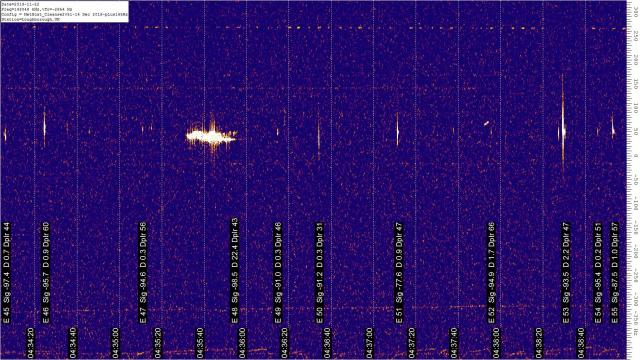
 Derek RobsonParticipant
Derek RobsonParticipantThanks Robin
Because the diffraction grating is only a recent addition in the last year, I have images through the CCTV camera without the grating, so I can hunt out a direct comparison frame. Bear with me and I’ll grab an image. I might be able to stack the two to see if any changes are obvious, but I might have to alter B, C, gamma, invert etc, to provide images that can easily be seen together as an overlay.
kind regards
Derek
 Derek RobsonParticipant
Derek RobsonParticipantHi Robin
Thanks for that, I will keep that in mind when checking. I have been zooming in on screen at times and making a mental qualitative note of separations, then scrolling along to the other side, and noting that distance. There may have been occasions where I’ve zoomed without realising, then thought, that distance looks different. I’ll find out later on in the quantitative analysis. I’m glad you made that point about lens distortion because, on my Watec camera [which is not these colour results] the lens shows some stars as blurred on left side, in focus in middle, and blurred again on right side but not as bad as on the left. (6mm lens). Spectra on that camera do show differences between + and – orders relative to zero order; and because the grating is just taped on the outside of the CCTV box, and is slightly curved across the front, and having seen the intense spectrum of the moon, that’s where I noticed the curvature, and got the idea it was due to curved grating. The pictures selected (the moon upper and a firework, lower) show the curvature more pronounced if the object is lower down (as in the case of the firework) – but the dispersion looks roughly symmetrical. Note, on the curved part, I try to make a linear pixel measurement as a best estimate, although I’m not sure whether I should be measuring the dispersion along the curve [or flattening that curve in e.g. BASS before dispersion is measured. But I know flattening can introduce errors, so I don’t want to go there. I’d rather take measurements when the dispersion is flat]
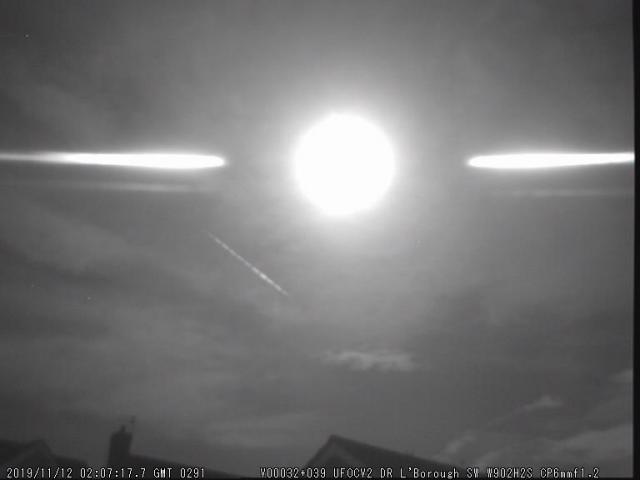

So it’s good to know that’s lens distortion. On the colour work, the lens is Canon 1100D with std 18-55 mm lens, set at 18 mm (and, on occasions, different f number (3.5, 8, 11, 22), stopping down because the sky was so bright. Would different f number affect/conceal those lens distortions you mention?
 Derek RobsonParticipant
Derek RobsonParticipant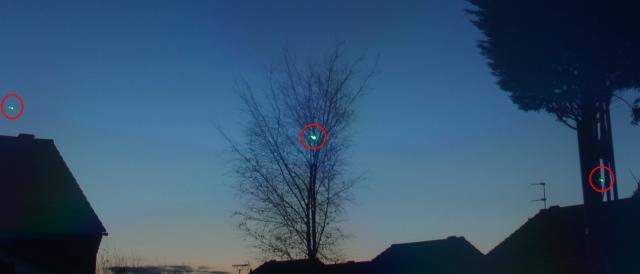


 Thanks Robin, will do. After the E&I meet, because it’s easy to set away APT running short 6s exposures during the night when dark enough, I was able to time and fire the green 532nm LASER and move around various targets whilst I could hear APT finish exposure, start exposure…..etc, so managed to build up a few shots to work with. Some will be squiggled, other’s nice and clean dots. I should be able to measure the dispersion in pixels (or mm on screen) and see what we get. I have a suspicion that I’m going to get slightly different dispersion distances for n = +1 and n = -1, possibly because of the grating, being plastic, it’s not completely flat but is curving. Depending on where the dot occurs, if it’s on a part that’s more curved, relative to the opposite side of the zero order image, we might get discrepancies there. All nice experimentation. could make decent experiments for school projects.
Thanks Robin, will do. After the E&I meet, because it’s easy to set away APT running short 6s exposures during the night when dark enough, I was able to time and fire the green 532nm LASER and move around various targets whilst I could hear APT finish exposure, start exposure…..etc, so managed to build up a few shots to work with. Some will be squiggled, other’s nice and clean dots. I should be able to measure the dispersion in pixels (or mm on screen) and see what we get. I have a suspicion that I’m going to get slightly different dispersion distances for n = +1 and n = -1, possibly because of the grating, being plastic, it’s not completely flat but is curving. Depending on where the dot occurs, if it’s on a part that’s more curved, relative to the opposite side of the zero order image, we might get discrepancies there. All nice experimentation. could make decent experiments for school projects. Derek RobsonParticipant
Derek RobsonParticipantHi Hugh
That’s a great piece of experimentation. It’s interesting to see what looks like a linear relationship. I wonder if this is a kinetic effect in the diode mechanism (Arrhenius equation etc)? compared to the transition in neodymium for the green light that Steve mentioned (maybe the transition in neodymium is not sensitive to temperature changes?). It’s all good because this discussion has led me to standardising on using the green LASER. In fact (out of curiosity) I may calibrate the blue and red LASERs using the green one as the primary standard. For meteor spectra surveys, it will be easy to make a green LASER calibration frame/s at the start or end of a batch of exposures [better at the start because of the dew formation later]. But I think once done and I have a value of the number of pixels the green LASER is dispersed in the first order diffraction, as long as the equipment stays the same, lens, focal length, grating, do you think the calibration will no longer be necessary ? Oh, I think I need to follow up with Robin’s comments on distance. I will need to do some exposures with various objects at different distances painted with the LASER. Robin, do you think it’s important to know the actual distances? A problem I have is, I don’t know the distances – they are just roof tops, aerials etc. Is there a way to work out their distances?
-
AuthorPosts
